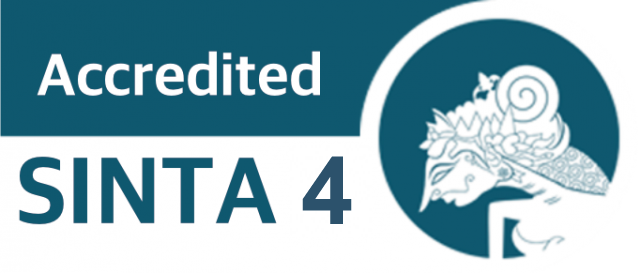PEMODELAN SISTEM OPTIMASI PENJADWALAN MATAKULIAH DENGAN ALGORITMA GENETIKA
Abstract
Scheduling courses at each university is a complicated and complex job because there are many constraints and rules that must be considered. Scheduling is also crucial in the teaching and learning process because lecturer and student activities depend on the schedule that has been prepared. General problems that need to be considered when scheduling are the possibility that the lecturer will teach more than one course and the possibility that the number of courses and lecturers is not balanced. The preparation of class schedules at the Universitas Sarajanawiyata Tamansiswa, Faculty of Engineering is still done manually using excel so that the process of preparing the schedule takes a long time so it is less effective.
This study aims to design a modeling system for optimizing course scheduling at the UST Faculty of Engineering with a Genetic algorithm in order to facilitate the development of a scheduling and optimize the time for preparing course schedules system. The data used is secondary data in the form of course scheduling data at the UST Faculty of Engineering even semester of the 2022/2023. The final result of this research is the scheduling optimization system modeling at the UST Faculty of Engineering. System process modeling is carried out using UML (Unified Modeling Language) which consists of 3 diagrams, namely Use Case Diagrams, Activity Diagrams, and Class Diagrams while modeling the analysis of data storage using ERD (Entity Relation Diagrams). In this study, 4 hard constraints and 3 soft constraints were applied which were the limitations in processing scheduling with genetic algorithms.
References
[2] T. Birbas, S. Daskalaki, and E. Housos, “School timetabling for quality student and teacher schedules,” J. Sched., vol. 12, no. 2, pp. 177–197, 2009, doi: 10.1007/s10951-008-0088-2.
[3] H. U. A. Hartadi Rudy and V. G, “Perancangan Aplikasi Penjadwalan Mata Kuliah,” J. Bianglala Inform., vol. 4, no. 1, pp. 31–40, 2016, doi: 10.4324/9781003221296-10.
[4] H. P. Hariyadi, T. Widiyaningtyas, M. Z. Arifin, and S. Sendari, “Implementation of Genetic Algorithm to academic scheduling system,” IEEE Reg. 10 Annu. Int. Conf. Proceedings/TENCON, pp. 2013–2016, 2017, doi: 10.1109/TENCON.2016.7848378.
[5] X. Chen, R. Yi, and M. Li, “Design and Application of an Improved Genetic Algorithm to a Class Scheduling System,” pp. 44–59.
[6] F. Mone and J. E. Simarmata, “Aplikasi Algoritma Genetika Dalam Penjadwalan Mata Kuliah,” BAREKENG J. Ilmu Mat. dan Terap., vol. 15, no. 4, pp. 615–628, 2021, doi: 10.30598/barekengvol15iss4pp615-628.
[7] A. Rudianto and I. Muhandhis, “Rancang Bangun Sistem Penyusunan Jadwal Pelajaran Menggunakan Algoritma Genetika Berbasis Web (study Kasus MI Mahalul Ulum),” J. Syst. Eng. Technol. Innov., vol. 1, no. 01, pp. 33–37, 2022, doi: 10.38156/jisti.v1i01.14.
[8] H. Ardiansyah and M. B. S. Junianto, “Penerapan Algoritma Genetika untuk Penjadwalan Mata Pelajaran,” J. Media Inform. Budidarma, vol. 6, no. 1, p. 329, 2022, doi: 10.30865/mib.v6i1.3418.
[9] S. D. Kristanti, P. Studi, T. Informatika, U. B. Darma, and K. Palembang, “Optimalisasi Sistem Penjadwalan Mata Kuliah Jurusan Bahasa Inggris Menggunakan Algoritma Genetika (Studi Kasus Politeknik Negeri Sriwijaya),” vol. 14, no. 2, pp. 22–31, 2022.
[10] C. Suranto, “Membangun Sistem Informasi Penjadwalan dengan Metode Algoritma Genetika pada Laboratorium Teknik Informatika UMMU Ternate,” J. Ilm. Ilmu Komput. dan Inform., vol. 1, no. 2, p. 65, 2018.
[11] T. Li, Q. Xie, and H. Zhang, “Design of College Scheduling Algorithm Based on Improved Genetic Ant Colony Hybrid Optimization,” Secur. Commun. Networks, vol. 2022, 2022, doi: 10.1155/2022/2565639.
[12] A. Voutama, “Sistem Antrian Cucian Mobil Berbasis Website Menggunakan Konsep CRM dan Penerapan UML,” Komputika J. Sist. Komput., vol. 11, no. 1, pp. 102–111, 2022, doi: 10.34010/komputika.v11i1.4677.
[13] R. N. Kurniawan et al., “Penjadwalan Penggunaan Perangkat Elektronik Menggunakan Algoritma Genetika,” vol. 9, no. 5, pp. 2167–2174, 2022.
[14] J. Y. Setiawan, D. E. Herwindiati, and T. Sutrisno, “Algoritma Genetika Dengan Roulette Wheel Selection dan Arithmetic Crossover Untuk Pengelompokan,” J. Ilmu Komput. dan Sist. Inf., vol. 7, no. 1, pp. 58–64, 2019, [Online]. Available: https://journal.untar.ac.id/index.php/jiksi/article/view/5882
[15] J. Suryaputra, C. Lubis, and T. Sutrisno, “Pemilihan Crossover pada Algoritma Genetika Untuk Program Aplikasi Pengenalan Karakter Tulisan Tangan,” J. Ilmu Komput. dan Sist. Inf., vol. 6, no. 1, pp. 69–72, 2018, [Online]. Available: https://journal.untar.ac.id/index.php/jiksi
[16] I. Hidayat, S. Revo, L. Inkiriwang, and P. A. K. Pratasis, “Optimasi Penjadwalan Menggunakan Metode Algoritma Genetika Pada Proyek Rehabilitasi Puskesmas Minanga,” J. Sipil Statik, vol. 7, no. 12, pp. 1669–1680, 2019, [Online]. Available: https://ejournal.unsrat.ac.id/v3/index.php/jss/article/view/26145
[17] Ade Hendini, “PEMODELAN UML SISTEM INFORMASI MONITORING PENJUALAN DAN STOK BARANG (STUDI KASUS: DISTRO ZHEZHA PONTIANAK),” J. KHATULISTIWA Inform., vol. IV, no. 2, pp. 107–116, 2016, doi: 10.1145/358315.358387.
[18] W. Aliman, “PERANCANGAN PERANGKAT LUNAK UNTUK MENGGAMBAR DIAGRAM BERBASIS ANDROID,” Syntax Lit. J. Ilm. Indones., vol. 6, no. 6, pp. 3091–3098, 2021, [Online]. Available: https://jurnal.syntaxliterate.co.id/index.php/syntax-literate/article/view/1404
[19] M. Larassati, A. Latukolan, A. Arwan, and M. T. Ananta, “Pengembangan Sistem Pemetaan Otomatis Entity Relationship Diagram Ke Dalam Database,” urnal Pengemb. Teknol. Inf. dan Ilmu Komput. , vol. 3, no. 4, p. 4059, 2019, [Online]. Available: http://j-ptiik.ub.ac.id
Copyright (c) 2023 TEKNIMEDIA: Teknologi Informasi dan Multimedia

This work is licensed under a Creative Commons Attribution-ShareAlike 4.0 International License.
Semua tulisan pada jurnal ini menjadi tanggungjawab penuh penulis. Jurnal Teknimedia memberikan akses terbuka terhadap siapapun agar informasi dan temuan pada artikel tersebut bermanfaat bagi semua orang. Jurnal Teknimedia dapat diakses dan diunduh secara gratis, tanpa dipungut biaya, sesuai dengan lisensi creative commons yang digunakan.

Jurnal TEKNIMEDIA : Teknologi Informasi dan Multimedia is licensed under a Lisensi Creative Commons Atribusi-BerbagiSerupa 4.0 Internasional


.png)





